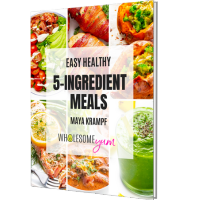
Free: Healthy 5-Ingredient Meals Ebook
Get It Now- Why You’ll Love This Roasted Beef Tenderloin Recipe
- What Is Beef Tenderloin?
- Ingredients & Substitutions
- How To Tie Beef Tenderloin
- How To Cook Beef Tenderloin
- What Is The Right Beef Tenderloin Internal Temp?
- How Long To Cook Beef Tenderloin?
- Tips For The Best Beef Tenderloin Recipe
- Storage Instructions
- What To Serve With Beef Tenderloin Roast
- More Perfect Steak Recipes
- Recommended Tools
- Roasted Beef Tenderloin Recipe (So Tender!) Recipe card
- Recipe Reviews
Is there anything more luxurious than a perfectly roasted beef tenderloin? Filet mignon has always been my favorite cut of steak, but more recently, I experimented and learned how to cook beef tenderloin roast whole — and I’m in love. This beef tenderloin recipe is simple but so impressive. Everyone will be wowed!
I use my favorite stovetop-to-oven method for this beef tenderloin recipe. Browning the meat on the stovetop creates a flavorful crust, while finishing it in the oven ensures that the inside remains juicy and tender. This method is perfect for a variety of cuts of meat, including baked pork chops, braised lamb shanks, succulent prime rib roast, and sirloin steak.
Why You’ll Love This Roasted Beef Tenderloin Recipe
- Moist, tender, and juicy inside
- Perfect golden crust
- Rich garlic butter flavor in every bite
- Melts in your mouth
- Perfect for a Christmas dinner and other special occasions
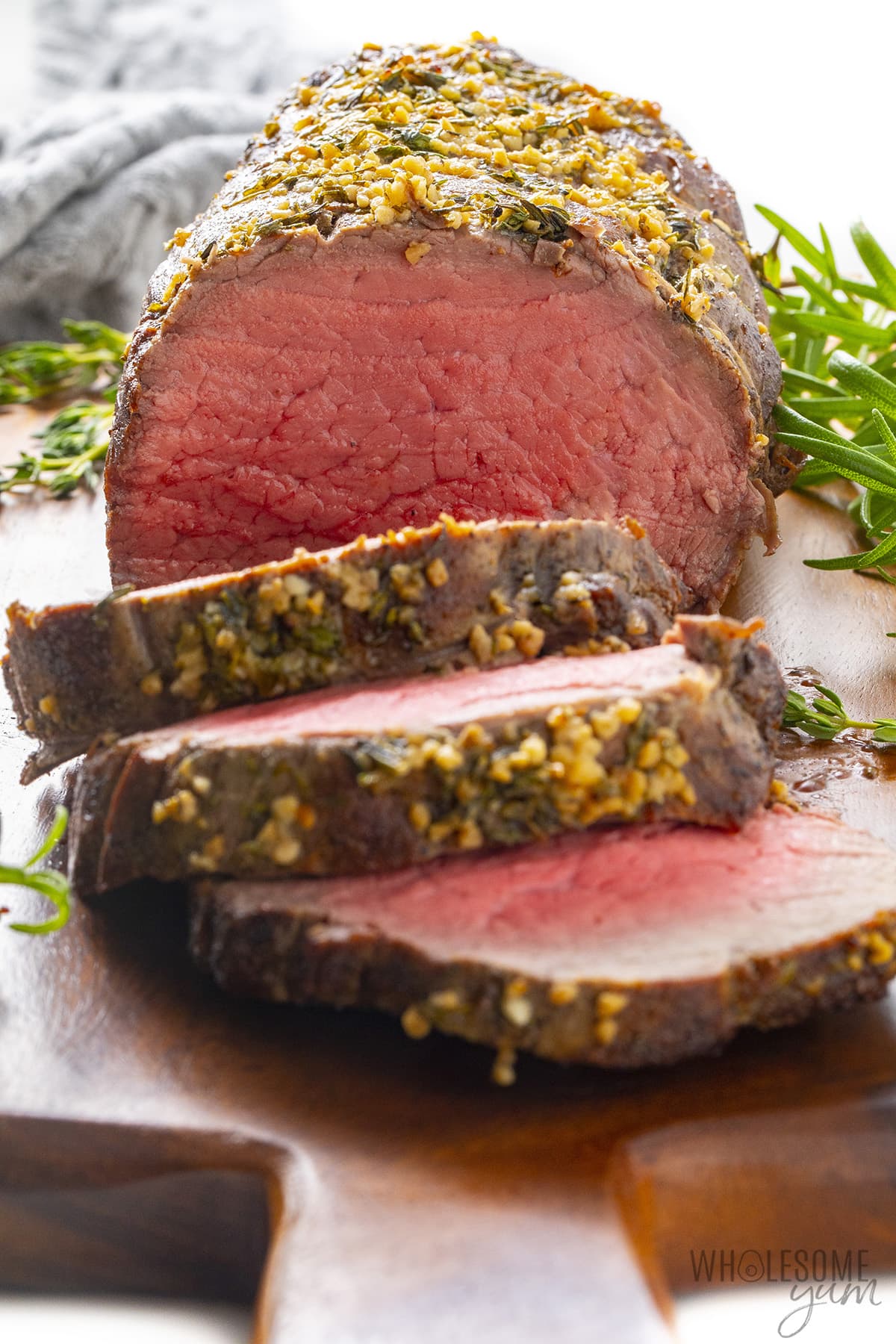
What Is Beef Tenderloin?
Beef tenderloin is a long, thick muscle that runs along the spine of the cow and is part of the beef loin. It’s. Because the muscle doesn’t do a lot of work, it is the most tender cut of beef. This cut can be sold as steaks, known as filet mignon, but you can also buy a beef tenderloin roast.
Ingredients & Substitutions
This section explains how to choose the best ingredients for this beef tenderloin roast recipe, what each one does in the recipe, and substitution options. For measurements, see the recipe card below.
- Beef Tenderloin – The best beef tenderloin recipe starts with quality meat! You’ll get fresher cuts from your local butcher rather than from a grocery store. The grade of meat will determine its tenderness and quality. Grades range from Prime (the best and most expensive, but very hard to find outside of high end restaurants) to Choice (this is the next best — get it if you can afford it!) to Select (which will work if that’s all you can find). I highly recommend getting the highest quality meat possible — you’ll taste the difference.
- Sea Salt & Black Pepper – Salt draws out moisture, creating a dry brine that is then re-absorbed back into the meat. This process breaks down the muscle proteins in the beef tenderloin, making it juicier and more tender. A good rule of thumb is 1 teaspoon of salt per pound of meat. Black pepper is for flavor and you can adjust to your preference.
- Butter – Use an unsalted variety, softened to room temperature. You can also use compound butter if you already have it made.
- Garlic – Fresh minced garlic tastes so much better in this beef tenderloin recipe, but you can use jarred if you must.
- Fresh Herbs – I used thyme and rosemary, but you can substitute your favorite fresh herbs.
- Dijon Mustard – Optional, but helps to tenderize the meat and adds flavor.
- Olive Oil – For searing. Feel free to substitute with any neutral heat-safe oil.
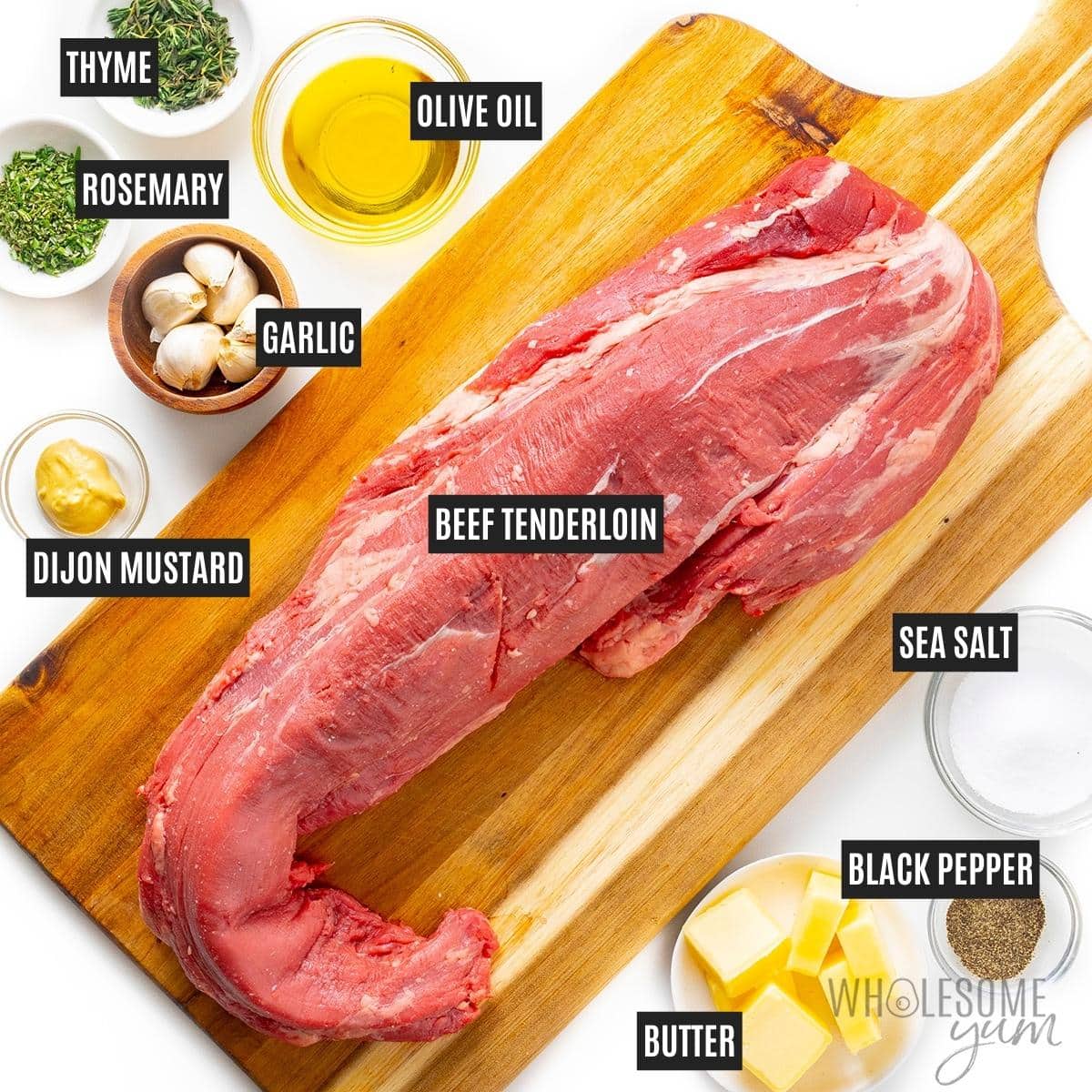
How To Tie Beef Tenderloin
Before you follow the beef tenderloin recipe, you’ll need to tie it with butcher’s twine. This will prevent it from spreading as it cooks, which means a nicer appearance and also helps lock the juices inside.
- Cut, trim, and tuck. Slice the tenderloin in half crosswise. Trim the edges to remove the silver skin. Tuck the long, thin end underneath, just enough so that the remaining thickness is uniform. You can also cut off any very thick part on the other end. Pat dry with paper towels. If you have time, place in the fridge, uncovered, overnight.
- Tie the first knot. Use kitchen twine and tie it in a knot on one end of your beef tenderloin.
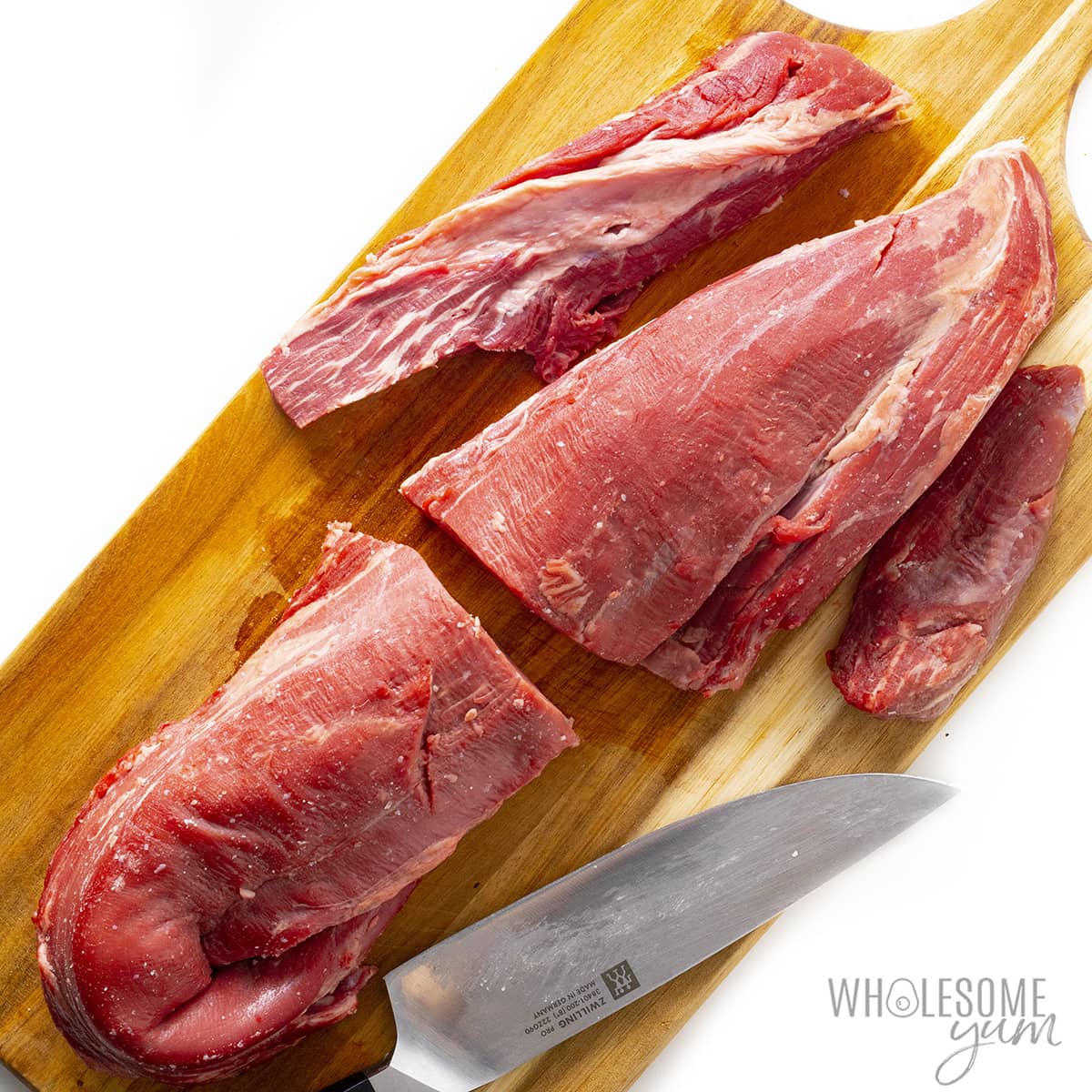

- Loop. Wrap the twine around your hand, and then pull it off your hand and over the tenderloin.
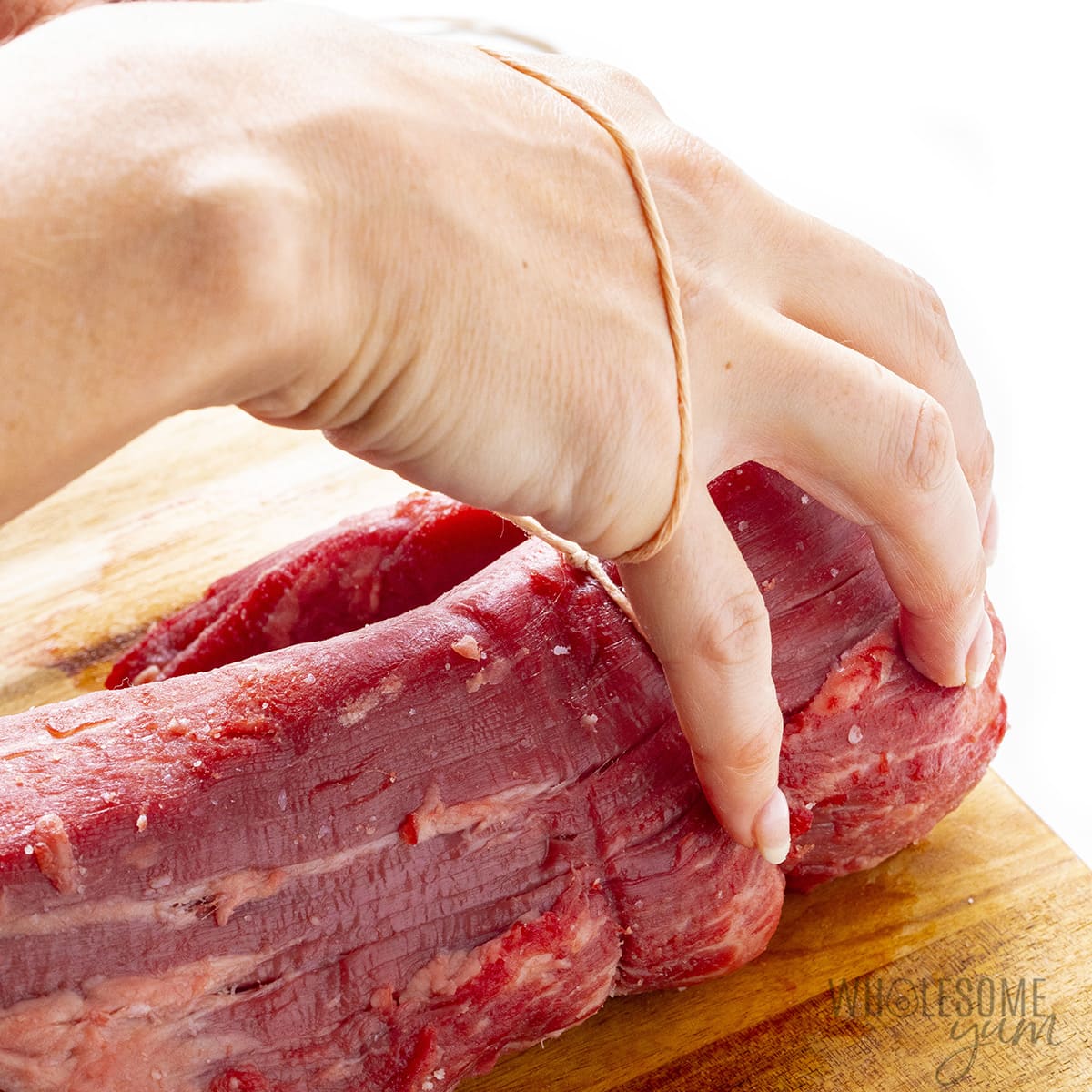
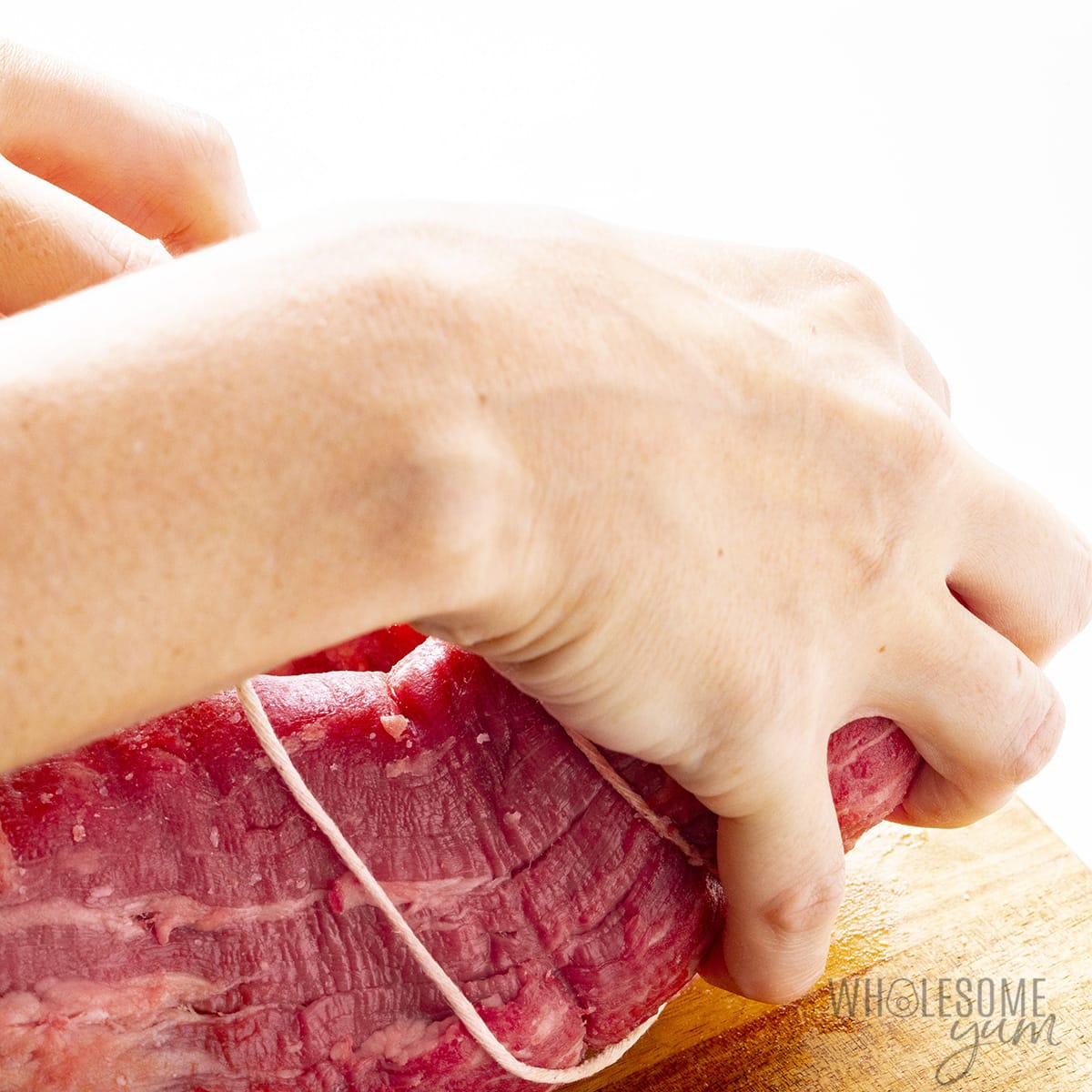
- Pull. Grab the twine and pull it tightly.
- Repeat. Repeat the above steps for the entire length of the tenderloin. When you reach the end, flip it over and pull the string around the end, to the other side.
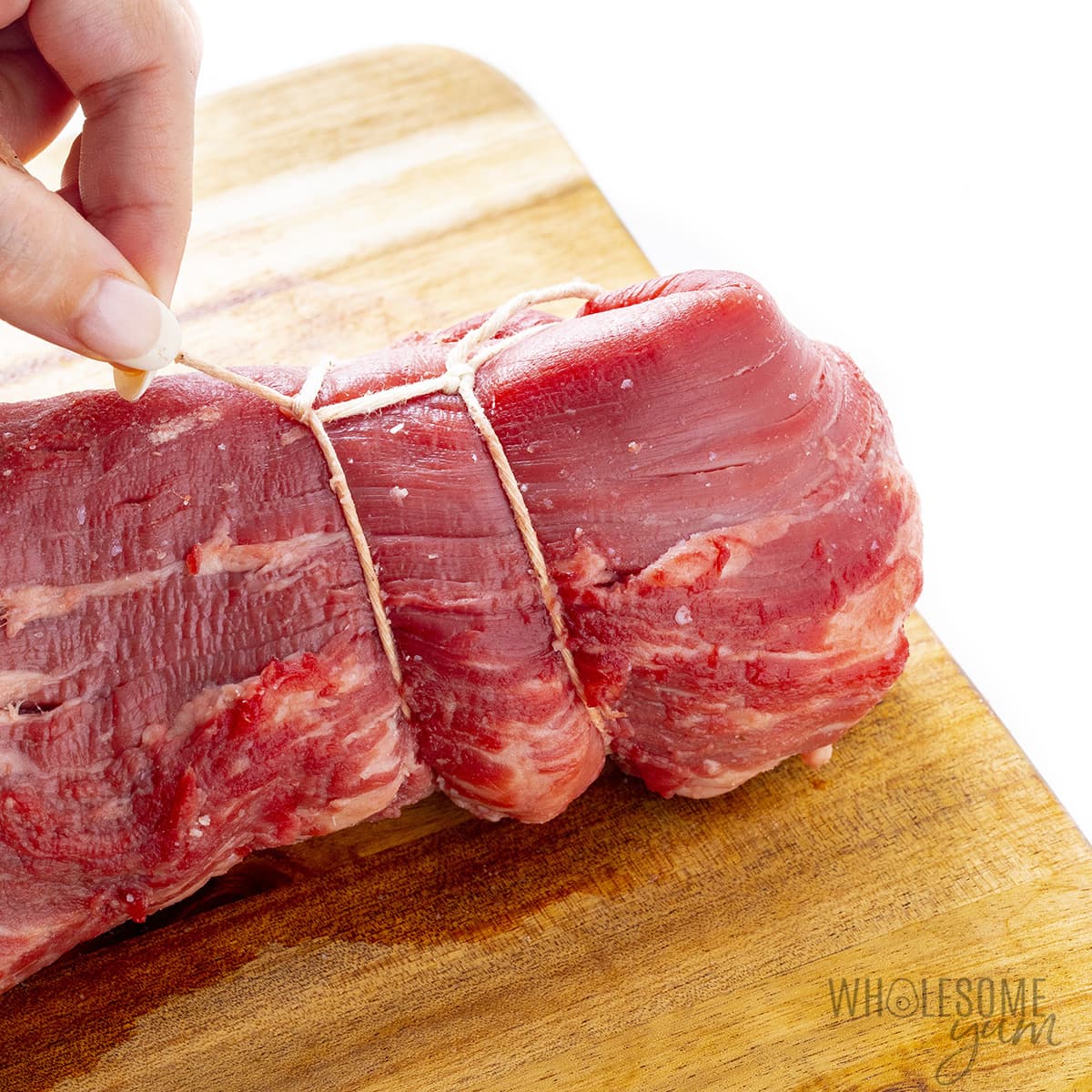
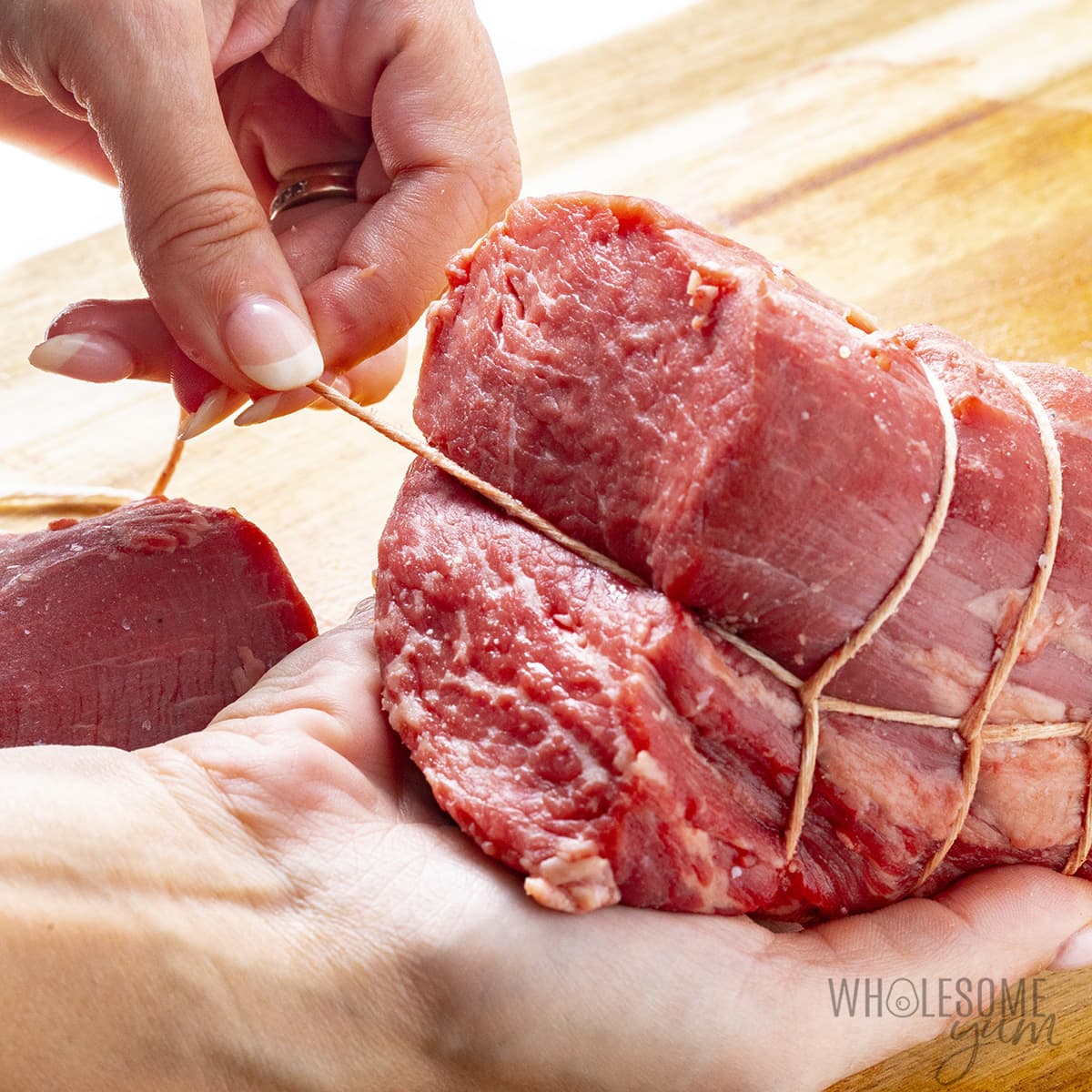
- Thread. Thread the string underneath the crosswise strings on the other side of the tenderloin.
- Tie. Pull the twine over the other end and tie a knot together with the first knot.

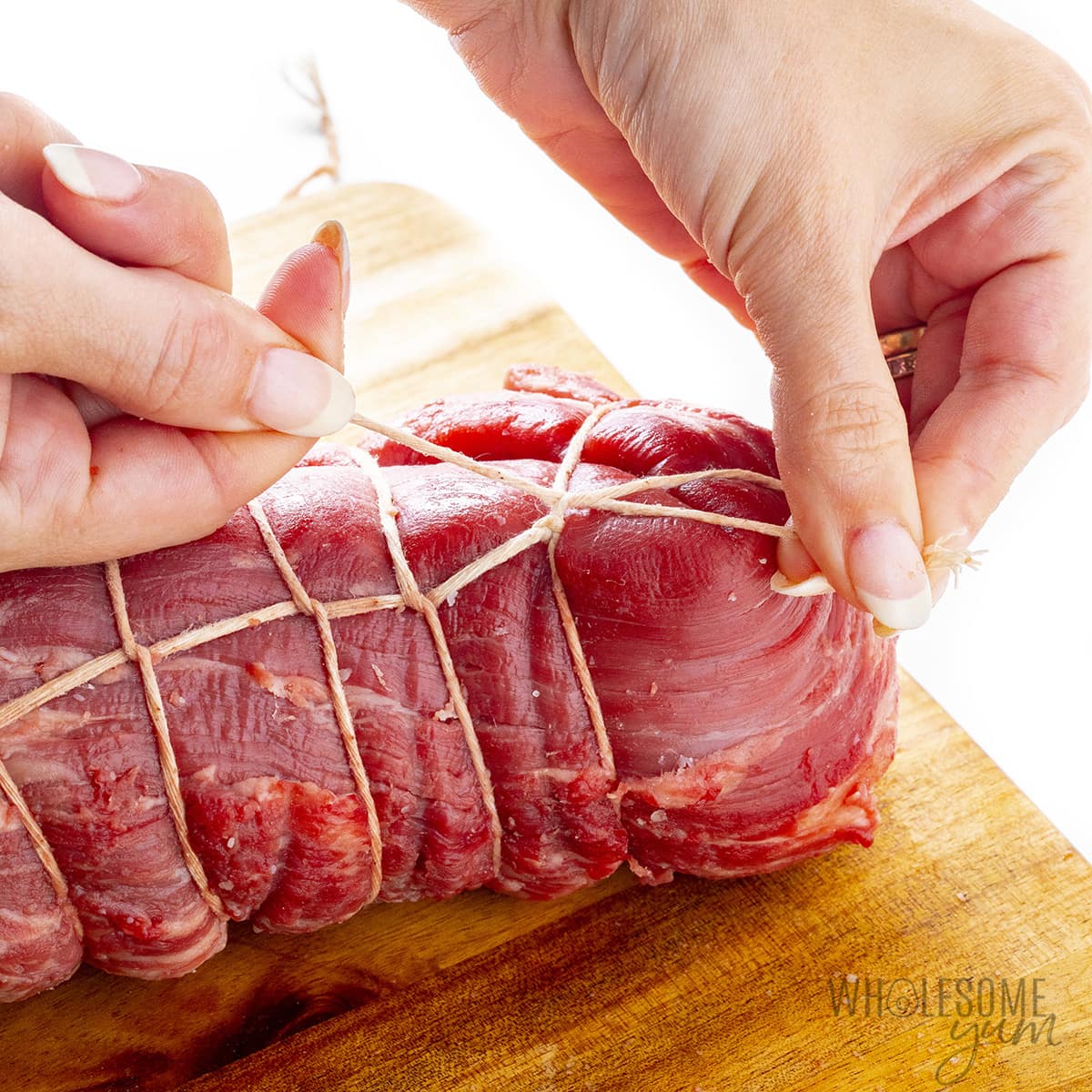
- Finish. Repeat all the steps above with the second piece of tenderloin. Below is how they should look when finished.
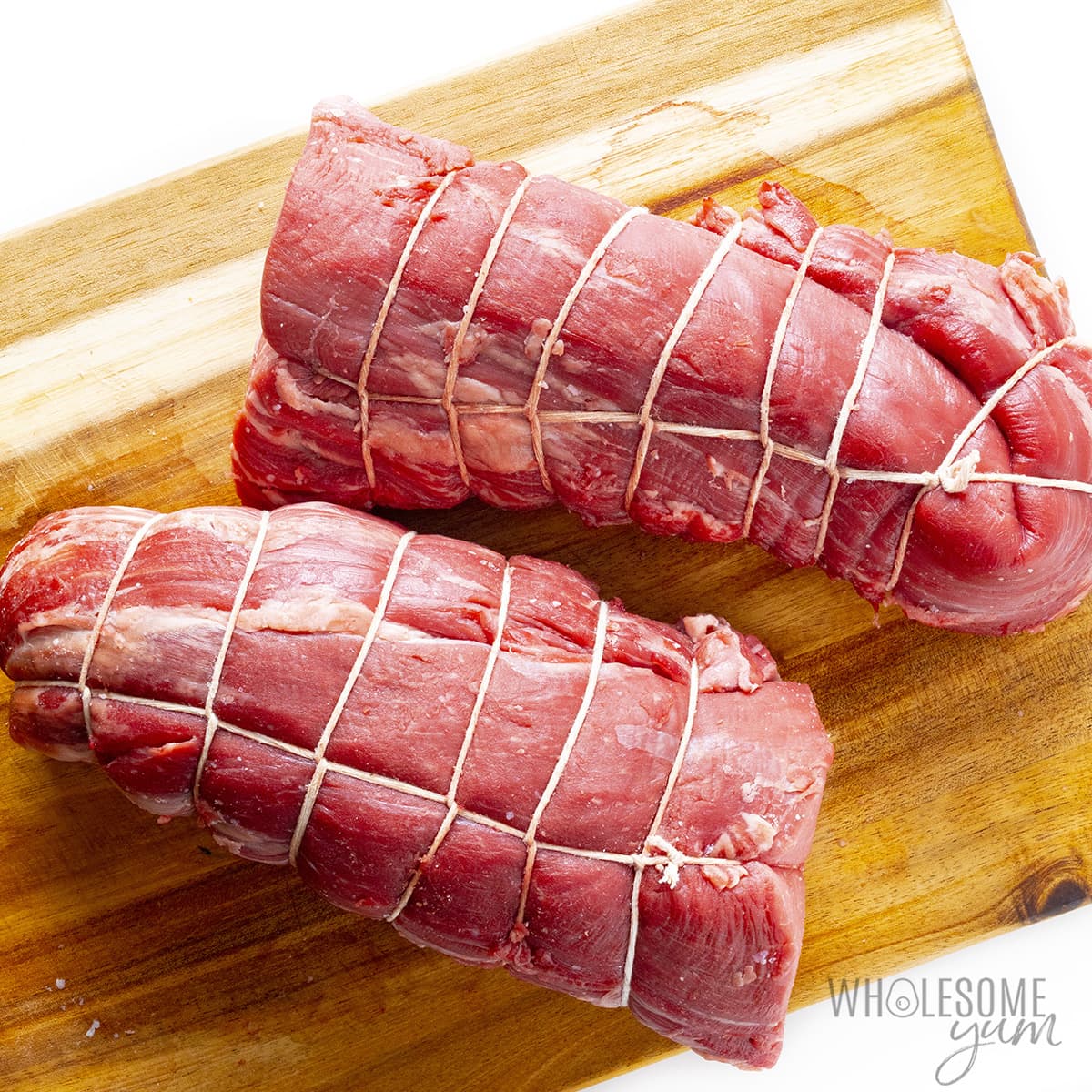
How To Cook Beef Tenderloin
This section shows how to cook tenderloin beef, with step-by-step photos and details about the technique, to help you visualize it. For full instructions, including amounts and temperatures, see the recipe card below.
- Season. Pat the beef dry with paper towels again. Season all sides generously with salt and pepper.
- Dry brine. Allow the seasoned roast to sit at room temperature for 1 hour before cooking.
- Make compound butter. In a small mixing bowl, mash together butter, garlic, rosemary, thyme, and Dijon mustard. Set aside.
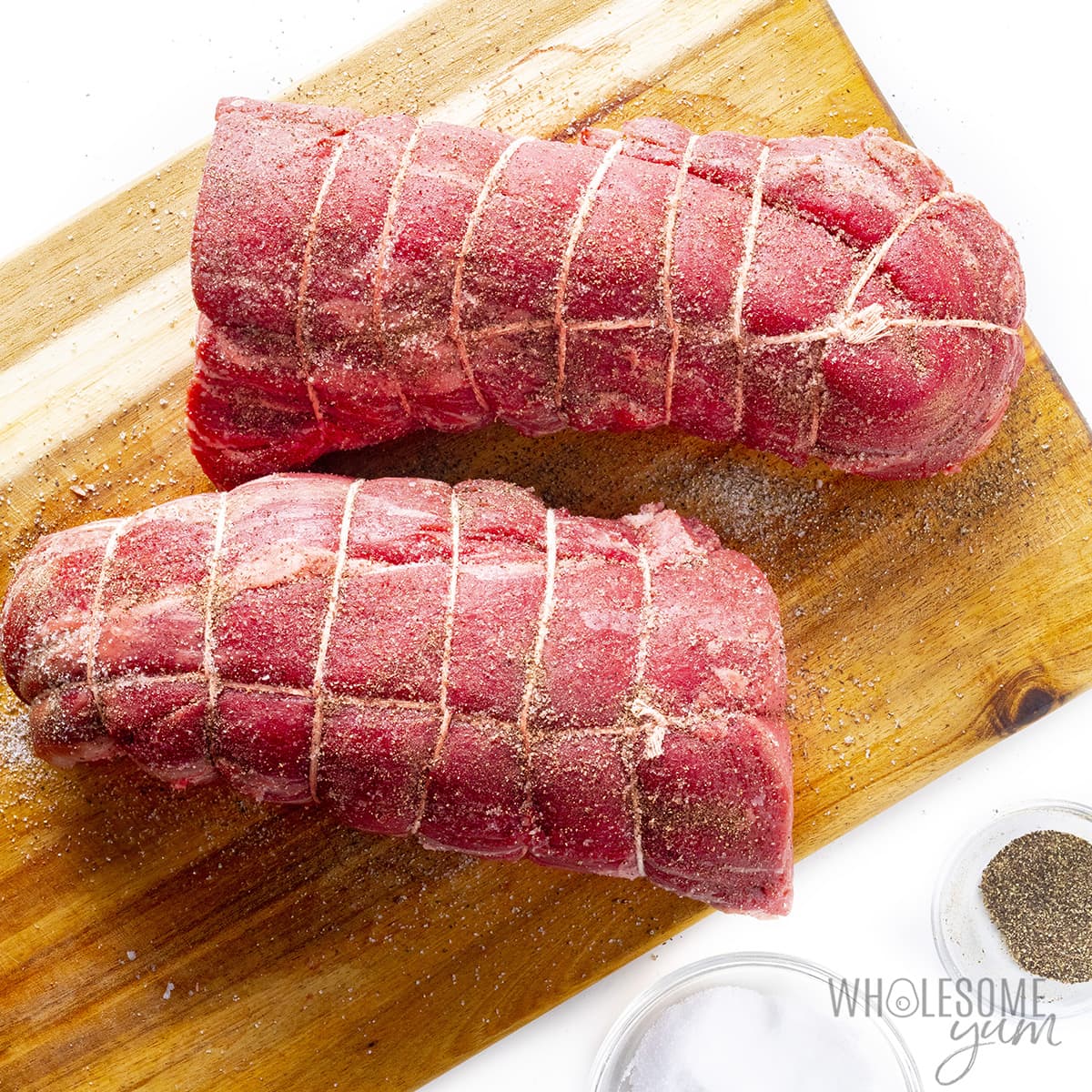

- Sear. Heat olive oil in a cast iron skillet over medium-high heat, until shimmering and screaming hot. Add the tenderloin pieces, without touching each other, and sear on all four sides until a golden brown crust forms. Sear for slightly less time on the last side.
TIP: When searing, use tongs for more control.
If the beef doesn’t want to stay on one of the sides, use tongs to hold it against the pan.
- Transfer. Immediately spread the butter mixture over the beef tenderloin recipe, insert a probe thermometer (if you have one) into the thickest part in the center, and transfer to the oven.
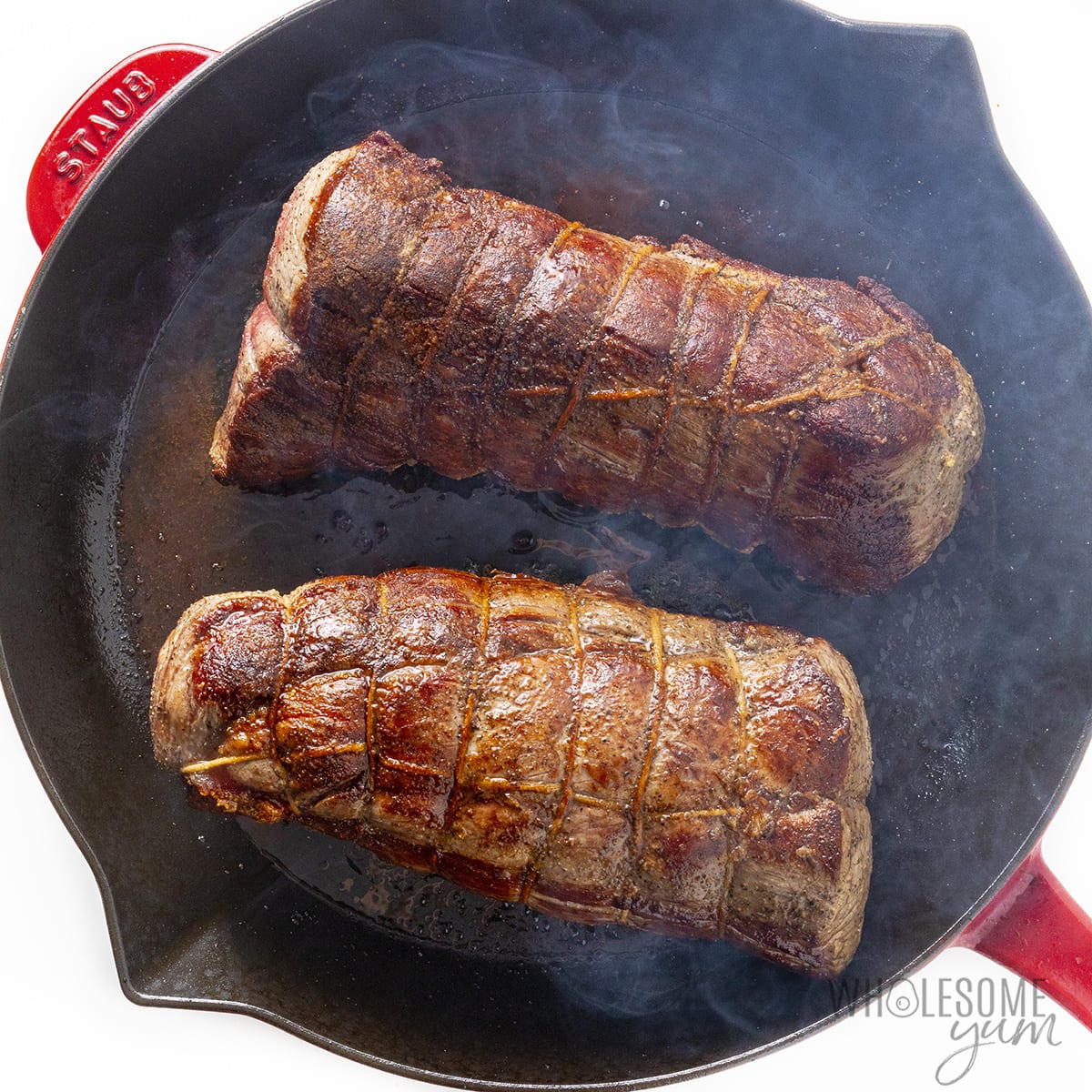
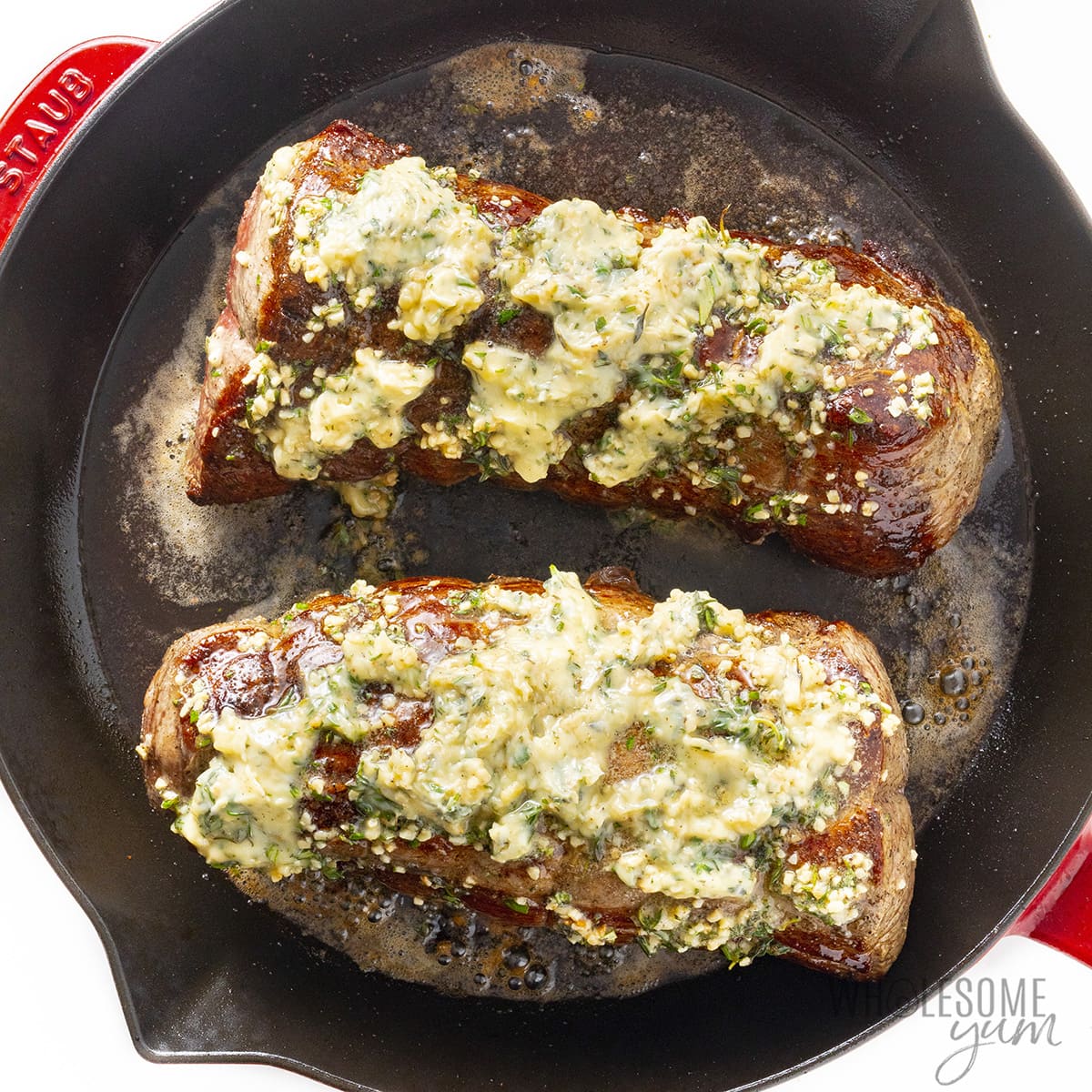
- Bake. Roast beef tenderloin in the oven until the internal temperature reaches 125 degrees F for medium rare, or your desired doneness. (See the time chart below.)
- Rest. Immediately transfer the oven roasted beef tenderloin to a cutting board, to prevent overcooking. Let it rest for 10-15 minutes to allow the juices to settle, before cutting into slices.
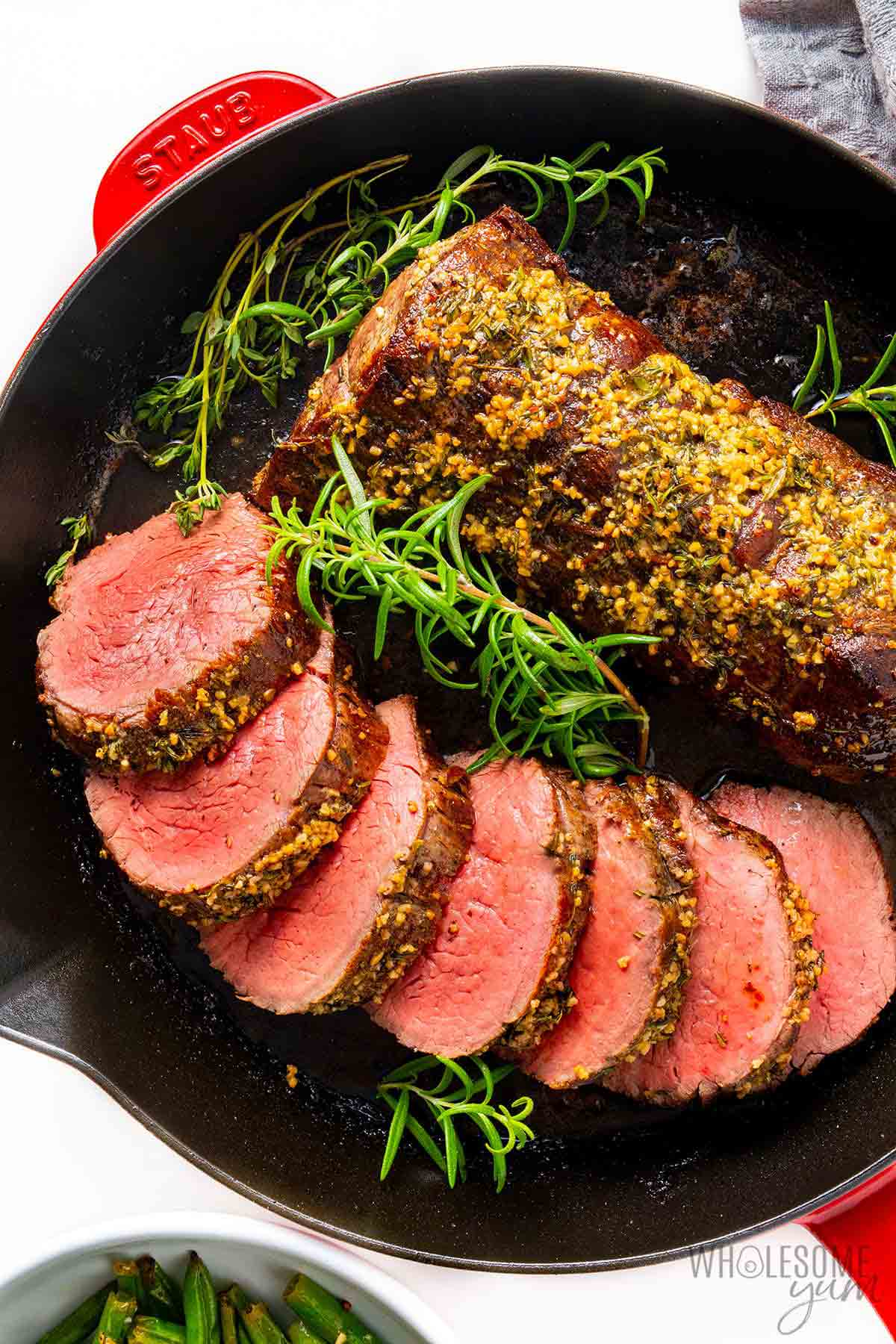
What Is The Right Beef Tenderloin Internal Temp?
Beef tenderloin recipes taste best done to medium rare (135 degrees F) or medium (145 degrees F). However, the internal temperature will rise about 10 degrees while resting after cooking, so remove it from the oven when it’s 10 degrees below the target temperature.
How Long To Cook Beef Tenderloin?
For a perfect medium-rare beef tenderloin that is 4 pounds, roast in the oven for 25-35 minutes after searing on the stovetop. If your beef is a different size, a good rule of thumb is 5-8 minutes per pound for rare, 6-9 minutes per pound for medium-rare, 7-10 minutes per pound for medium, or 8-11 minutes per pound for medium well.
For best results, use a meat thermometer (or even better, a probe thermometer, which will beep when it hits the right temperature) to know exactly when it’s done. But if you don’t have one, use the time chart below.
Beef Tenderloin Cook Time Chart
| Doneness | Brown On The Stove | Then Oven For | Target Temperature * |
|---|---|---|---|
| Rare | 2-3 minutes per side | 20-30 minutes | 115 degrees F |
| Medium Rare | 2-3 minutes per side | 25-35 minutes | 125 degrees F |
| Medium | 2-3 minutes per side | 30-40 minutes | 135 degrees F |
| Medium Well | 2-3 minutes per side | 35-45 minutes | 145 degrees F |
NOTE: The meat temperature will rise another 10 degrees as it rests. The guidelines above are the temperature that the steak should be when you take it out of the oven, before resting.
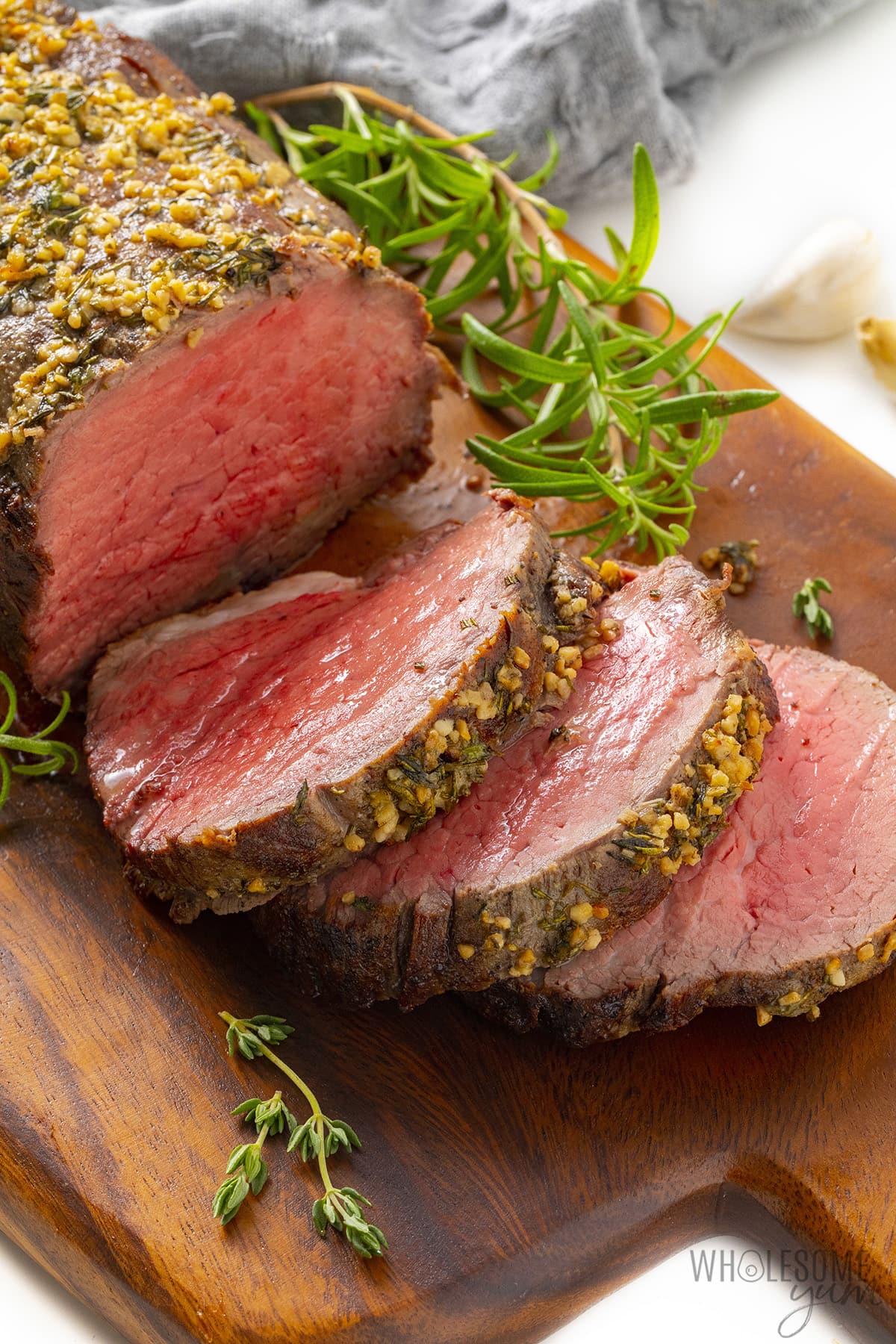
Tips For The Best Beef Tenderloin Recipe
Beef tenderloin is an expensive cut of meat, so you want to make sure the end result is melt-in-your-mouth perfect! Here are my tips for success:
- Tie it tightly. See instructions above. This ensures that the meat doesn’t spread, so it looks beautiful and the juices stay locked inside.
- Dry in the fridge overnight if you can. If you have time, place the tenderloin in the fridge, uncovered, for 8-12 hours or overnight — you can do this before or after tying it. (This is not absolutely necessary, but helps create a better outer crust when searing.)
- Bring to room temperature before cooking. This helps the meat cook evenly. Plus, since this recipe lets it come to room temp after you season it, the salt and pepper acts as a dry brine.
- Use the right pan. I highly recommend a cast-iron pan like this one. Other materials don’t heat as evenly and won’t give that nice sear. But if your pan is not oven-safe, you can transfer to a roasting pan with rack instead.
- Sear at high heat. High heat is critical to getting a good crust on your roasted beef tenderloin.
- Don’t overcook. Since this is a lean cut of beef, it will be dry if you cook it to medium well or well done. I recommend medium rare to medium doneness. For best results, use a meat thermometer (it will cost you less than the tenderloin itself!) and the time chart above as a guide.
- Let it rest. You may feel tempted to cut into your roast immediately after cooking, but don’t do it! All the juices will spill out and you’ll end up with dry steak.
- Slice against the grain. This breaks up the muscle fibers, for the most tender texture when you eat.
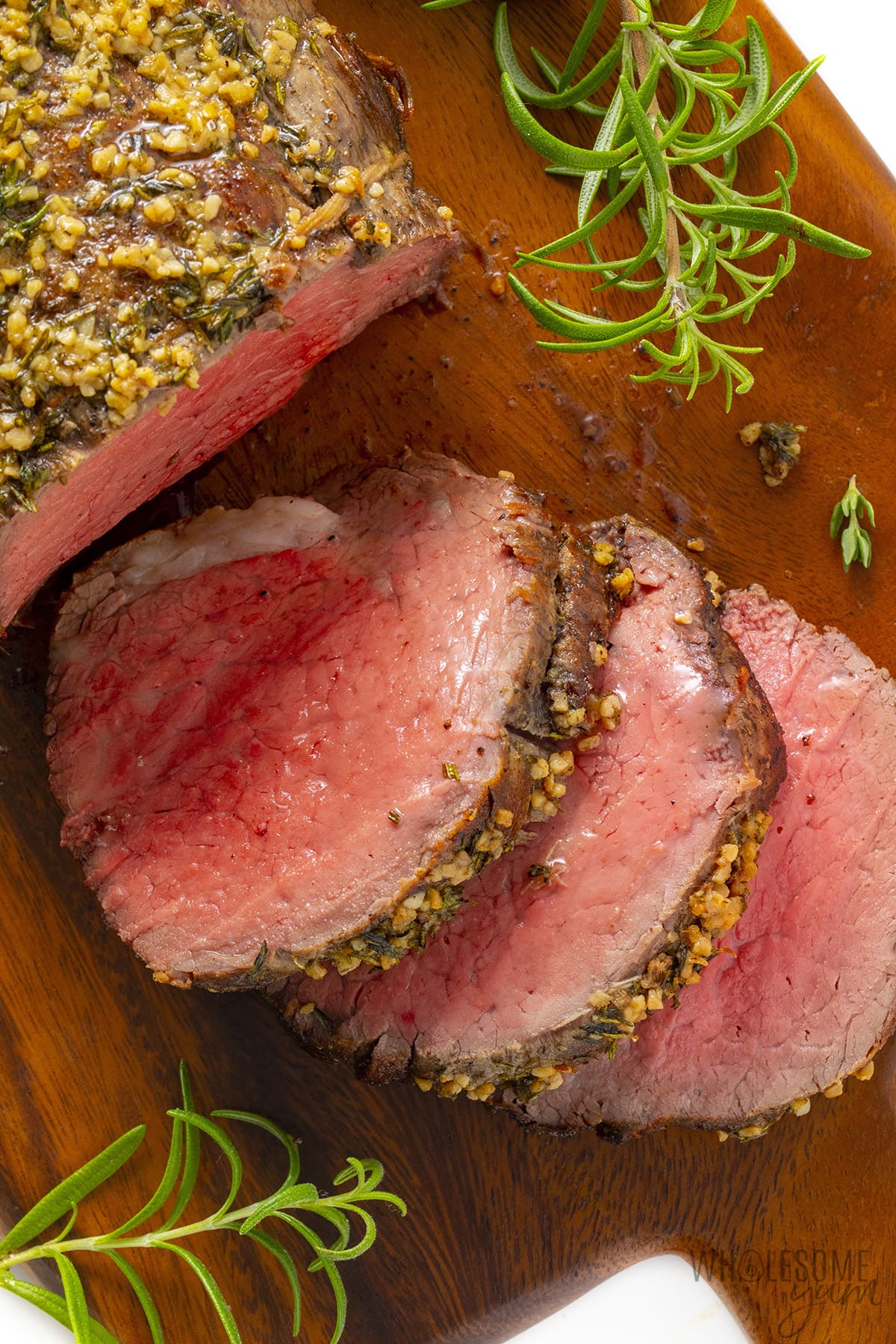
Storage Instructions
- Store: Keep leftovers in an airtight container in the refrigerator for up to 2-3 days.
- Reheat: I find it best to reheat roasted beef tenderloin in the oven at a low temperature such as 250-300 degrees F. Wrap the tenderloin in 2 layers of foil and place directly onto the oven grates, and bake for about 10-15 minutes, until warm. Avoid using a baking dish, which will lead to overheating.
- Freeze: You can freeze this beef tenderloin recipe for 2-3 months. It’s best to freeze before cooking, but if you have leftovers you want to freeze, you still can.
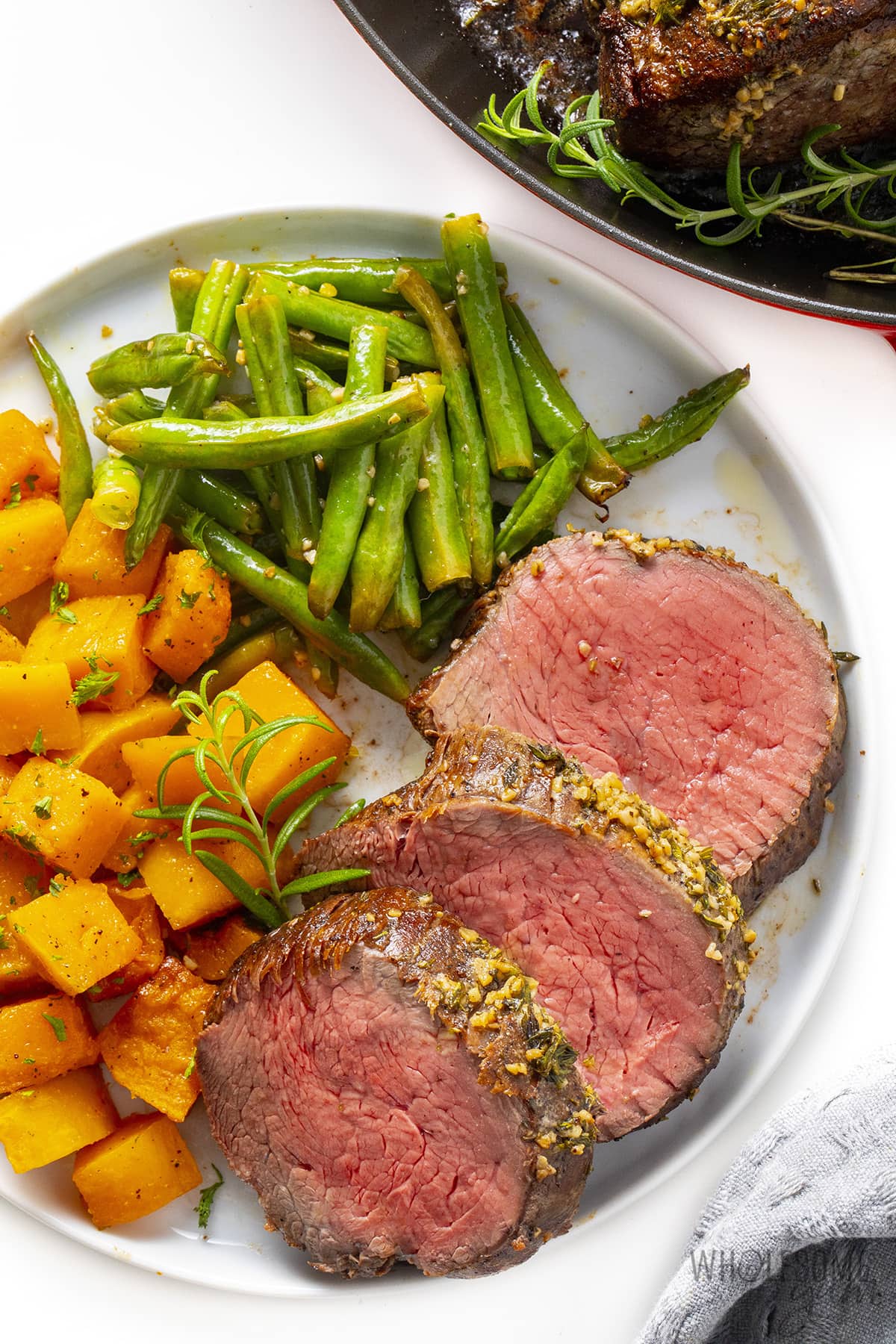
What To Serve With Beef Tenderloin Roast
This roasted beef tenderloin recipe can be served with a variety of sides. Here are a few ideas:
- Vegetables – This meat pairs perfectly with roasted green beans with garlic (shown in the photos above), cabbage steaks, and roasted broccoli. For a fancier meal, pair it with green beans almondine.
- Starchy Sides – Serve your beef with mashed sweet potatoes, simple oven roasted potatoes, roasted rutabaga for a lighter option, or roasted butternut squash (shown in photos above) for a fall meal.
- Steakhouse Classics – Try beef tenderloin with buttery sauteed mushrooms, classic creamy spinach, wedges of air fryer sweet potatoes, or a simple blue cheese wedge salad.
- Sauces – This cut is so tender that it doesn’t need a sauce, but red wine sauces or creamy horseradish sauce are complimentary if you like them.
More Perfect Steak Recipes
Once you know how to cook tenderloin beef, it opens a whole world of steak recipes! If you liked this tender and juicy beef tenderloin recipe, you’ll enjoy these delicious ones as well:
Recommended Tools
- Kitchen Twine – A must for tying a roast.
- Cast Iron Skillet – Heats evenly and retains heat extremely well, so it’s ideal for searing and oven roasting.
- Probe Thermometer – This one beeps when your beef tenderloin recipe cooks to your desired doneness.
Roasted Beef Tenderloin Recipe (So Tender!)
Learn how to cook the best roast beef tenderloin recipe perfectly every time, with garlic, butter, and herbs. It's melt-in-your-mouth tender!
Instructions
Tap on the times in the instructions below to start a kitchen timer while you cook.
-
Cut the beef tenderloin in half crosswise. Pat dry with paper towels. If you have time, place the beef tenderloin in the fridge, uncovered, for 8-12 hours or overnight. (This is not absolutely necessary, but helps create a better outer crust when searing, so do it if you can.)
-
Tuck the long, thin end underneath. Use kitchen twine to tie each piece of tenderloin tightly, at one-inch intervals – see post above for instructions and pictures for how to tie it.
-
Pat the beef with paper towels again. Season all over with salt and pepper. Let it come to room temperature on the counter for 1 hour before cooking.
-
Preheat the oven to 400 degrees F (204 degrees C).
-
In a small bowl, mash together the butter, garlic, rosemary, thyme, and Dijon mustard (if using). Set aside.
-
Heat the olive oil in a large cast iron skillet over medium-high heat, until shimmering and very hot. Add the beef tenderloin pieces, without touching each other, and sear on all four sides, about 2-3 minutes per side, until a brown crust forms. (If the beef doesn’t want to stay on one of the sides, use tongs to hold it against the pan.) Sear for slightly less time on the last side, as it will continue to sear while you spread on the butter in the next step.
-
Working quickly, immediately spread the butter mixture over the beef, insert a probe thermometer into the thickest part in the center, and transfer to the preheated oven. (Alternatively, if searing in a pan that is not oven-safe, transfer to a roasting pan before placing in the oven.)
-
Roast beef tenderloin in the oven until it reaches your desired internal temperature: 115 degrees F for rare (20-30 minutes), 125 degrees F for medium rare (25-35 minutes), 135 degrees F for medium (30-40 minutes), 145 degrees F for medium well (35-45 minutes), or 155 degrees F for well done (40-50 minutes). (Temperature will continue to rise while resting in the next step.) For the juiciest beef, medium rare to medium is recommended.
-
To prevent overcooking, immediately transfer the roasted beef tenderloin to a cutting board after removing from the oven. Let it rest for 10-15 minutes to allow the juices to settle – the internal temperature will rise an additional 5-10 degrees.
Did You Like It?
Leave a rating to help other readers, or get the recipe sent to your inbox.
Recipe Notes
Serving size: ~1/3 lb (weight prior to cooking), or 1/12 of the entire cooked beef tenderloin
Nutrition facts are provided as a courtesy. Have questions about calculations or why you got a different result? Please see our nutrition policy.
© Copyright Maya Krampf for Wholesome Yum. Please DO NOT SCREENSHOT OR COPY/PASTE recipes to social media or websites. We’d LOVE for you to share a link with photo instead. 🙂
Roasted Beef Tenderloin Recipe
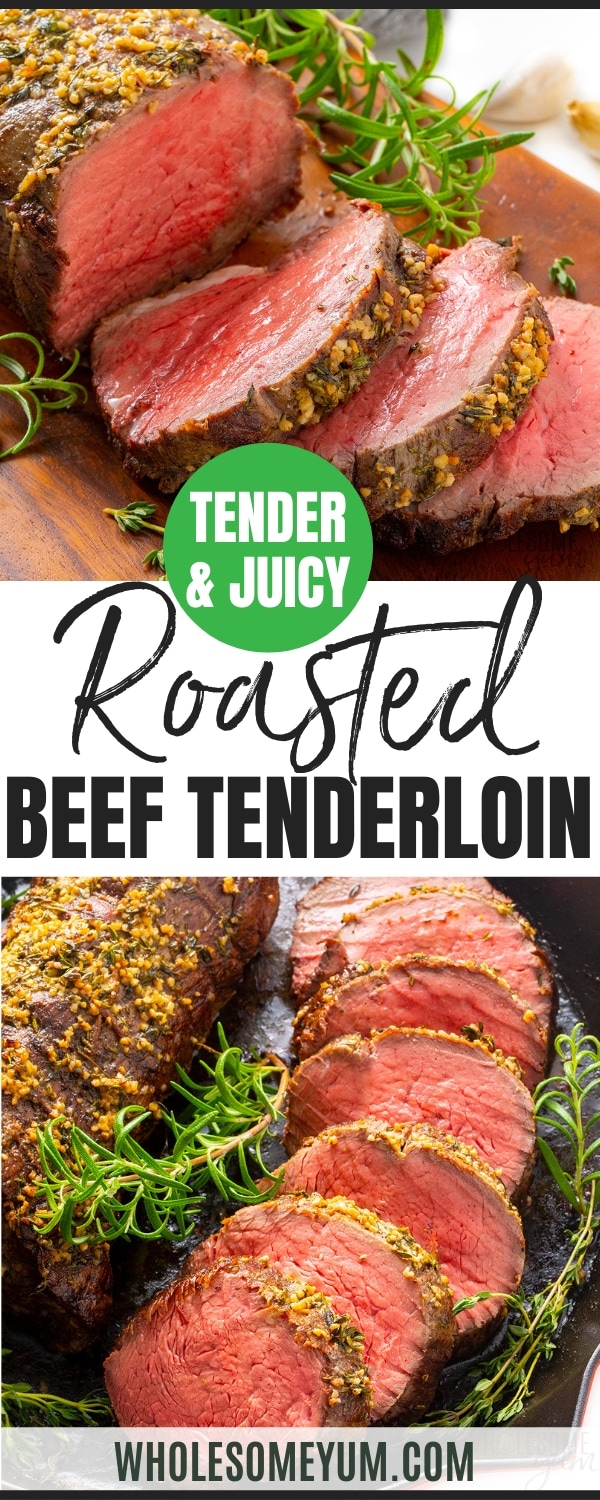
 My
My Shop
Shop Wholesome Yum
Wholesome Yum
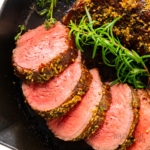


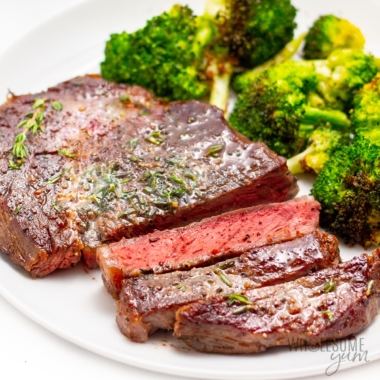
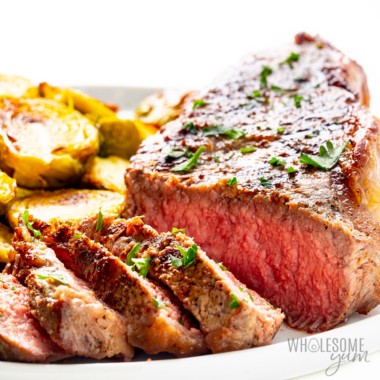
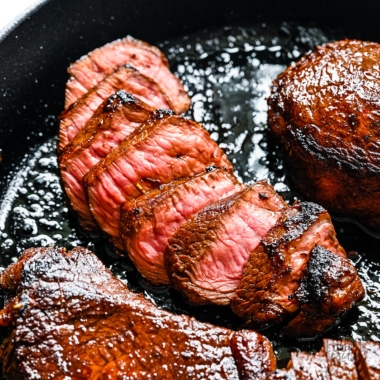
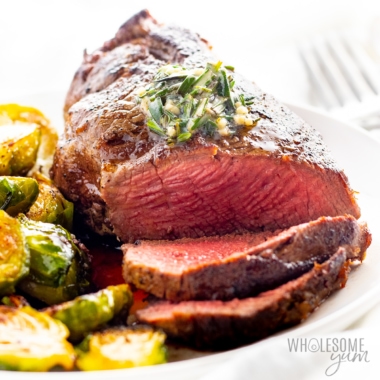
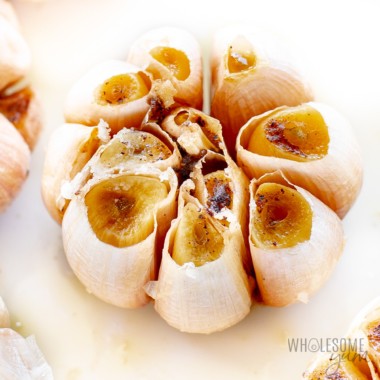
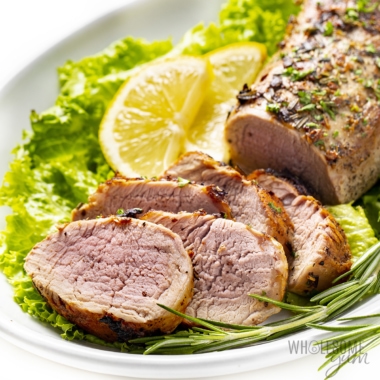
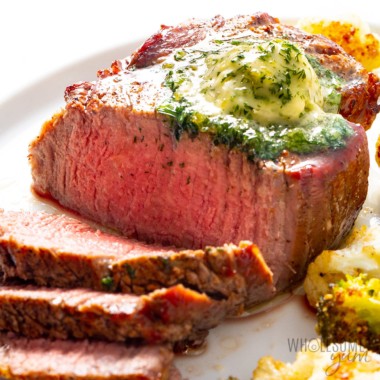
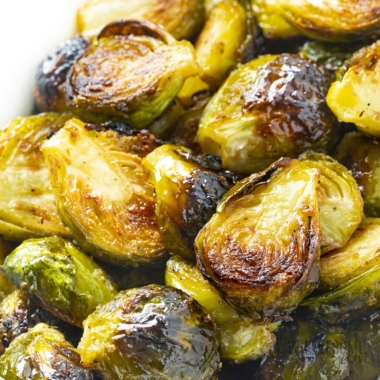

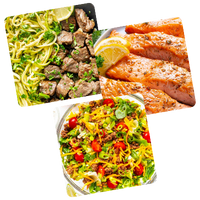




13 Comments
Phil
0You never state what temperature to set the oven.
Melanie Kueterman
0I absolutely cannot wait to try this recipe. I will have a 5# tenderloin cut locally and wanted the best possible recipe for it. will be making it in 4 weeks and cannot wait! Do you have a recipe for a nice red wine or horseradish sauce to serve with it?
Wholesome Yum D
0Hi Melanie, I don’t currently have a recipe for horseradish sauce.
Naomi
0Hello there! Looking forward to giving this recipe a try! One question, though, the herbed butter sounds amazing, but with rubbing it on while the beef is hot and then putting it right into the oven, does it just drip off of the meat? Wondering if it will have a chance to season it properly? 🤔 But I guess I can just make it and see! Thank you!
Maya | Wholesome Yum
0Hi Naomi, It does start to melt a little when you put it on, but you can see in the process pictures above it doesn’t all melt instantly. In my experience the meat still absorbs most of the butter. Let me know what you think when you try it!
Naomi
0Well, well, well.
I have done a lot of cooking and baking in my day and love making food for friends and family. I think that I got the most positive feedback on anything I have made literally ever in my life on this tenderloin. They LOVED it and raved about it all night. Every time I read a review like that on a recipe I’m always mildly in disbelief until it happened to me! 😛 I decided to kill two birds with one stone and added the salt to the tenderloin the night before when leaving it to dry in the fridge overnight, and adding the butter worked out just fine as you suggested. I had a four pound cut of meat, and had it in the preheated oven for only 13-14 minutes and that wound up being just perfect. Thank you for making me the hero of my kitchen! 🙂
Trudi Warner
0what oven temperature, it did not give that??
Wholesome Yum D
0Hi Trudi, Preheat the oven to 400 degrees F. That information is listed in step 4 on the recipe card.
Betty
0This looks so good. I don’t know if i can afford it but i am going to give it a try. Thanks for the awesome step by step lesson on how to prepare it
Abby
0Making this to main dish for Christmas this year because it was so outstanding! Easy instructions to follow and turned out perfect.
Olivia
0Had this for dinner the other night and the whole family loved it! Cooked it medium-rare and it was so tender and delicious. So happy I found this recipe, thank you!
Jessica
0Mmmm! I gave this a test run before the holidays and it’s a definite must to make again. So flavorful, thank you!
James A Crowder
0Love this recipe and will give it a try these coming holidays. Butter always makes anything better much better. Butter and garlic, you can’t go wrong.